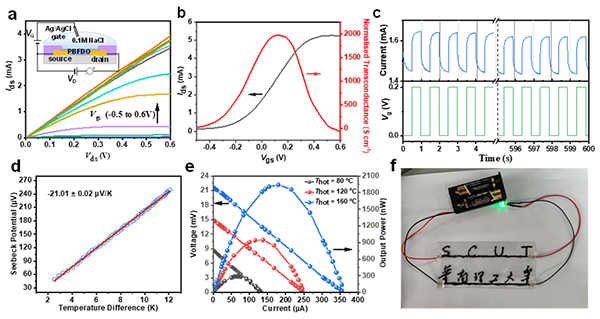Supported by the National Natural Science Foundation of China (grant No.U21A6002) and other projects, Prof. Fei Huang, Prof. Yong Cao, Prof. Yuguang Ma (State Key Laboratory of Light Emitting Materials and Devices, South China University of Technology), Prof. Yuanzhu Zhang, Prof. Xugang Guo (Southern University of Science and Technology), Prof. Jian Pei (Peking University) and their teams have innovatively proposed a new strategy for realizing the synthesis of n-type conducting polymers with ultrahigh electrical conductivity and excellent stability. The achievement was published online in Nature on September 8, 2022, entitled ‘A solution-processed n-type conducting polymer with ultrahigh conductivity’ (http://www.nature.com/articles/s41586-022-05295-8).
Since the discovery of the conducting polyacetylene in the 1970s, ‘synthetic metals’ has become an emerging field in polymer science. However, the insoluble and non-melting features of polyacetylene make it difficult to be processed. In 1992, Prof. Yong Cao proposed the idea of ‘counter-ion induced processibility’ to achieve the solution processing of the conducting polyaniline , based on which the first polymeric flexible light-emitting device was prepared, pioneering the field of organic flexible electronics. However, polyaniline and the subsequently developed PEDOT by Bayer Inc. are both p-type conducting polymers, and no significant progress has been made in n-type counterparts. Prof. Yuguang Ma succeeded Yong Cao’s idea to continually promote the study of solution-processable organic semiconductors with strong interactions, and achieved some important breakthroughs in n-type conducting and ferromagnetic semiconductors based on perylene diimide derivatives. Very recently, Prof. Fei Huang and his group focused on exploring new strategy to improve the conductivity of n-type conducting materials, and exciting breakthroughs in the field of organic conducting polymers have been realized.
The research team combined oxidative polymerization and reductive doping to produce n-type conducting polymers, poly(benzobifurandione) (PBFDO), with conductivity up to 2000 S cm-1 through a facile one-pot method. The strong interaction between the conjugated backbone and the solvent through doping endows PBFDO with excellent solution processability in the absence of alkyl side chains or surfactants. In addition, PBFDO has a very deep reduction energy level (-5.2 eV), resulting in requisite stability for practical applications(Fig. 1).

Fig.1 Synthesis mechanism of PBFDO
Based on the unprecedented conductivity and stability of PBFDO, a variety of organic electronic devices were fabricated. The organic electrochemical transistors exhibited a high transconductance of 1970 S cm-1 and excellent operational stability, n-type organic thermoelectric devices can be prepared for stable operation in air with a power factor close to 90 μW m-1 K -2, and flexible electrodes were successfully printed, etc. At present, based on this intellectual property of the State Key Laboratory of Light Emitting Materials and Devices, Dongguan VOLT-AMP OPTOELECTRONICS Inc. has laid out the manufacture of PBFDO and its related products to promote their practical applications(Fig. 2).

Fig.2 Application of PBFDO in organic electronic devices. (a-c) Organic electrochemical transistors; (d,e) Organic thermoelectric generators; (f) Flexible printed electrodes

Add: 83 Shuangqing Rd., Haidian District, Beijing, China
Postcode: 100085
Tel: 86-10-62327001
Fax: 86-10-62327004
E-mail: bic@donnasnhdiary.org
京ICP备05002826号 文保网安备1101080035号 Copyright 2017 NSFC, All Right Reserved